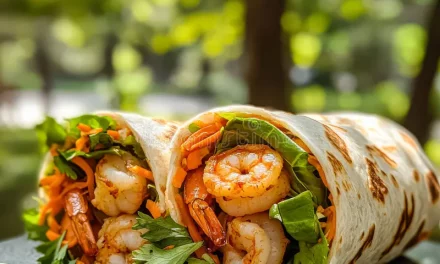Pico de Gallo Salsa Recipe and History
Pico de Gallo, also known as “salsa fresca” or “fresh salsa,” is one of Mexico’s most iconic condiments — bright, zesty, and bursting with fresh flavor. Made with simple ingredients like tomatoes, onions, jalapeños, cilantro, and lime juice, it’s a staple in Mexican cuisine and a perfect example of how freshness defines great food. This chunky, uncooked salsa is versatile, healthy, and easy to make — a refreshing companion to tacos, grilled meats, or tortilla chips.
The History of Pico de Gallo
The name Pico de Gallo literally translates to “rooster’s beak.” Historians believe it originated from people pinching the salsa between their thumb and forefinger — resembling a pecking motion — before tortilla chips became the standard accompaniment.
Pico de Gallo has deep roots in Mexican culinary tradition. It dates back centuries to pre-Columbian times when the Aztecs and Mayans combined native ingredients like tomatoes, chilies, and herbs to create flavorful condiments. Over time, as trade introduced new ingredients like onions and limes, the recipe evolved into the fresh, tangy mix we know today.
Unlike cooked salsas, Pico de Gallo is always made with raw ingredients. This preserves the crisp texture of the vegetables and the vibrant acidity of lime juice, making it a refreshing complement to the spicy, rich flavors of traditional Mexican dishes.
Ingredients
- 4 ripe Roma tomatoes, finely diced
- 1 medium white onion, finely chopped
- 1–2 jalapeño peppers, seeded and minced (or serrano for extra heat)
- ½ cup fresh cilantro, chopped
- Juice of 1–2 limes (to taste)
- Salt to taste (about ½ teaspoon)
- Optional: 1 small clove of garlic, minced
Instructions
- Prepare the Vegetables:
Dice the tomatoes and onion into small, even pieces. Mince the jalapeños finely — the smaller the cut, the better they distribute the heat. - Combine Ingredients:
In a large bowl, combine the tomatoes, onion, jalapeños, and cilantro. - Add Lime and Seasoning:
Squeeze fresh lime juice over the mixture, then sprinkle with salt. Mix gently with a spoon until evenly combined. - Rest Before Serving:
Let the salsa sit for about 10–15 minutes before serving. This allows the flavors to blend and the lime juice to slightly soften the vegetables. - Serve Fresh:
Serve immediately or refrigerate for up to 3 days in an airtight container.
This recipe makes about 2 cups and serves 4–6 people.
Tips for the Perfect Pico de Gallo
- Use Ripe Tomatoes: Overripe tomatoes make the salsa watery, while underripe ones lack flavor. Roma or plum tomatoes work best.
- Balance Lime and Salt: Lime adds acidity, while salt enhances flavor. Start with small amounts and adjust to taste.
- Drain Excess Liquid: If the salsa seems watery, strain before serving to keep it crisp.
- Customize Heat: For mild flavor, remove all jalapeño seeds and ribs. For more spice, keep some intact or use serrano peppers.
- Fresh Cilantro: Always use fresh cilantro for authentic aroma and taste — dried herbs won’t work for this dish.
Variations
- Fruity Pico: Add diced mango, pineapple, or watermelon for a tropical twist.
- Avocado Pico de Gallo: Stir in chopped avocado just before serving for a creamy touch.
- Cucumber Pico: Add diced cucumber for extra crunch and coolness.
- Roasted Corn Pico: Mix in grilled corn kernels for a smoky flavor.
Nutritional Benefits
Pico de Gallo is not just delicious — it’s incredibly healthy. Low in calories and fat-free, it’s rich in vitamins, antioxidants, and fiber.
- Tomatoes are packed with lycopene, a powerful antioxidant that supports heart health.
- Onions and garlic contain compounds that help regulate blood pressure and cholesterol.
- Jalapeños are high in vitamin C and capsaicin, known to boost metabolism.
- Cilantro provides antioxidants and aids digestion.
- Lime juice adds vitamin C and enhances iron absorption from other foods.
This fresh salsa aligns perfectly with heart-healthy, anti-inflammatory diets like the Mediterranean or DASH plan.
Serving Suggestions
Pico de Gallo is one of the most versatile sides or condiments you can make. Try it:
- As a topping for tacos, burritos, quesadillas, or enchiladas.
- Over grilled chicken, fish, or shrimp for a bright finish.
- Mixed into rice, beans, or quinoa bowls.
- Served with tortilla chips or whole-grain crackers as a healthy snack.
- On top of scrambled eggs or omelets for a flavorful breakfast twist.
Its light, tangy freshness complements rich dishes and adds balance to any meal.
The Legacy of Pico de Gallo
Pico de Gallo is more than a salsa — it’s a reflection of Mexico’s love for bold yet balanced flavors. Each region of Mexico has its own version, from milder northern styles to spicier southern renditions. What remains constant is its simplicity and freshness — a combination of ingredients that represent the earth’s bounty and the joy of shared meals.
Whether you’re enjoying it in a beachside taco stand in Cancún or in your kitchen at home, Pico de Gallo connects you to centuries of Mexican culinary tradition — vibrant, communal, and full of life.
References:
- BBC Good Food. (2024). Classic Pico de Gallo Recipe. Retrieved from https://www.bbcgoodfood.com
- Food Network. (2024). Authentic Mexican Pico de Gallo Salsa. Retrieved from https://www.foodnetwork.com
- Smithsonian Magazine. (2023). The Origins of Pico de Gallo and Mexican Salsa Culture. Retrieved from https://www.smithsonianmag.com
- TasteAtlas. (2024). Traditional Mexican Salsas and Their Regional Variations. Retrieved from https://www.tasteatlas.com
- Harvard University Press. (2023). Latin Flavors: The Culinary Heritage of Mexico and the Americas. Retrieved from https://www.harvard.com





